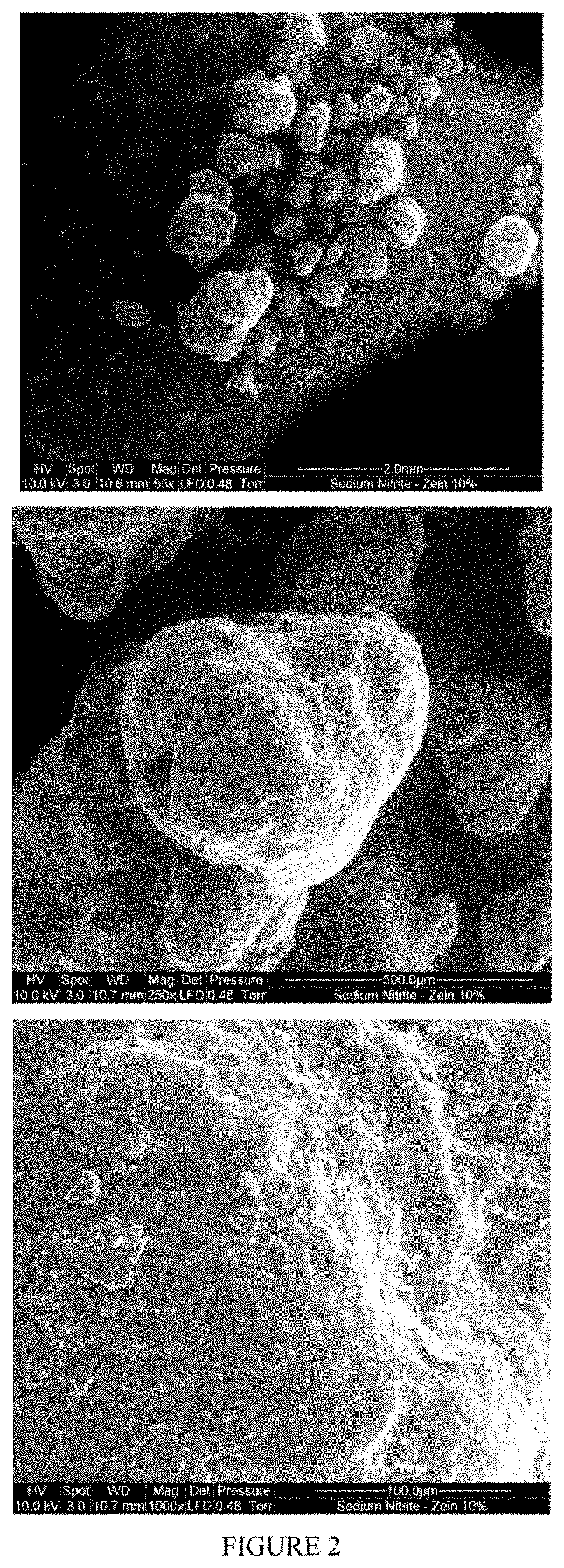Nitrite microencapsulation, and uses of microencapsulated nitrite in the manufacture of pest baits
- Summary
- Abstract
- Description
- Claims
- Application Information
AI Technical Summary
Benefits of technology
Problems solved by technology
Method used
Image
Examples
example 2
on of Encapsulated Bait Composition
[0134]a) Formulation Components
[0135]The ratio of these ingredients is:
Sodium Nitrite 100%95% End microsphereEncapsulates as a coat one -as a % of the Sodium NitriteEthanol50.000%EvaporatedWater12.500%EvaporatedZein12.375%Total of 5%PVP 0.125%
[0136]b) Formulation Process (Coated Pan)
[0137]Technical grade prilled sodium nitrite—(200-800 μm) was obtained from BASF. The sodium nitrite is heated in a coating pan at 45 deg C. for 30 minutes with the pan being jogged during this process. At the end of this process, the moisture content should be <0.1%. w / w.
[0138]The encapsulant comprising zein and PVP (Polyvinylpyrrolidone) is mixed / dissolved in binary solvent 70% ethanol / 30% water.
[0139]The coated nitrite is then formulated with a palatable carrier that further protects the nitrite from degradation and offers the mixture in a palatable form for the feral pig to eat. In this carrier bait consists of peanut paste and peanut oil mixed with dried ground ce...
example 3
on of Encapsulated Microspheres (Zein / PVP Based)
[0148]Production Method for Spheres:
[0149]Prilled sodium nitrite with a moisture content of less than 1% (typically around 0.2 to 0.3%) and a particle size distribution of 180 to 800 microns is suspended as a fluidised bed in a stream of air drawn into the coating apparatus at 80% relative humidity at 12° C. and which is pre-heated heated to 40 to 45° C. Coating material for zein is prepared by fully dissolving 10% w / w zein protein in a binary solvent comprising 70% ethyl alcohol and 30% deionised water and containing polyvinyl pyrilodone (PVP) as a plasticiser to form the coating solution.
[0150]The coating solution is sprayed on the fluidised bed of sodium nitrite granules initially at a low rate initially and then at a progressively increasing rate to provide an even and uniform coating layer until 2.5 to 25% coating of the particles with zein is achieved, typically 5% w / w of the finished product. The finished coated microsphere prod...
example 4
uction Using Microspheres from Example 3
[0151]A palatable bait containing sodium nitrite is prepared by mixing cracked wheat, fine crushed maize, white wheat flour, sugar, iron oxide (colourant) and sodium carbonate (as a pH modifier) until uniform colour is achieved in a ribbon blender. Then the required quantity of microencapsulated sodium nitrite microspheres is added and fully mixed with the dry ingredients before the whole mixture is bound together with a quantity of ground peanut paste to achieve a semi solid paste like consistency at room temperature.
PUM
 Login to View More
Login to View More Abstract
Description
Claims
Application Information
 Login to View More
Login to View More - R&D
- Intellectual Property
- Life Sciences
- Materials
- Tech Scout
- Unparalleled Data Quality
- Higher Quality Content
- 60% Fewer Hallucinations
Browse by: Latest US Patents, China's latest patents, Technical Efficacy Thesaurus, Application Domain, Technology Topic, Popular Technical Reports.
© 2025 PatSnap. All rights reserved.Legal|Privacy policy|Modern Slavery Act Transparency Statement|Sitemap|About US| Contact US: help@patsnap.com



